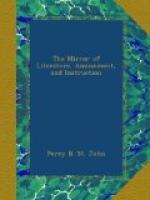“These shal be to advertise yor lordship of the Quenes estate. Yesterdaie afternonne she had an naturall laxe, by reason whereof she beganne sumwhat to lyghten, and (as it appeared,) to amende; and so contynued till towards night. All this night she hath bene very syck, and doth rather appaire than amend. Her Confessor hath bene with her grace this morning, and hath done [all] that to his office apperteyneth, and even now is preparing to minister to her grace the sacrament of unction. At Hampton Court, this Wednesday mornyng, at viii of the clock."[17]
As a further and additional proof of the date of her decease, we shall refer our readers to a manuscript, preserved in the Herald’s College, the preamble of which runs as follows:—“An ordre taken and made for the interrement of the most high, most excellent, and most Chrysten Pryncess, Jane, Quene of England, and of France, Lady of Ireland, and mother of the most noble and puyssant Prynce Edward; which deceasyd at Hampton Courte, the xxixth yere of the reigne of our most dread Soveraigne Lord Kyng Henry the eight, her most dearest husband, the xxiiiith day of Octobre, beyng Wedynsday, at nyght, xii of the clock; which departyng was the twelf day after the byrthe of the said Prynce her Grace beying in childbed.” By this document it is fixed on the second Wednesday after the birth of the prince, on the morning of which day, the abovementioned letter of her physicians was undoubtedly written, as the ministering of the holy unction would show that her death was fast approaching.
The remains of Jane Seymour were conveyed with great solemnity to Windsor, and interred in the choir of St. George’s Chapel, on the 12th of November. The following epitaph was inscribed to her memory:—
Phoenix Jana iacet, nato Phoenice dolendum,
Secala Phoenices nulla tulisse duas.
Of which Fuller gives this quaint translation—
Soon as her Phoenix Bud was blown,
Root-Phoenix Jane did wither,
Sad, that no age a brace had shown
Of Phoenixes together.
The funeral rites were solemnized according to the forms of the Catholic faith. The original letter[18] from Richard Gresham to the Lord Privy Seal, dated “Thurssdaye the viiith day of Novbr.” is still preserved, proposing that a solemn dirge, and masses should be said for the soul of the late Queen Jane, in St. Paul’s, in presence of the Mayor, Alderman, and Commoners, which were accordingly performed, as appears from the following passage in Holinshed:—“There was a solemne hearse made for her in Paule’s Church, and funerall exequies celebrated, as well as in all other churches within the Citie of London."[19]




